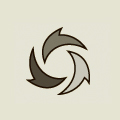|
FIN CONFIGURATIONS
|
|
|
|
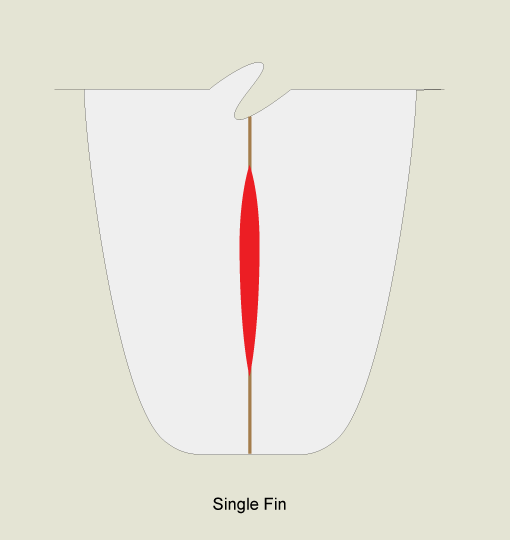
|
|
|
|
|
SINGLE FINS Single fins were common to all surfboards with few
exceptions from the first surfboards with fins to well into the
shortboard revolution. Initially all single fins were "glassed on"
until Tom Morey and Bill Bahne developed "fin boxes" to facilitate
removable fins and fin placement forward and aft. Turning with a
single fin is limited, meaning single fins are ideal for fast,
straight shot surfing. Well foiled single fins of various
configurations and depth offer a predictable, controlled, and stable
feel to longboards, mid lengths, and classic or contemporary single
fin shortboards. |
|
|
|
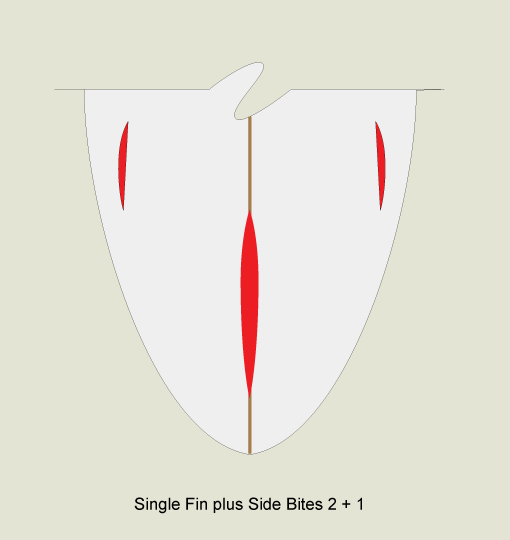
|
|
|
|
|
2 + 1 FINS The 2 + 1 fin configurations feature a glassed on or removable
box single fin lined up in the center of a surfboard with two regular
thruster rail fin boxes near both rails. Center fins feature a
symmetrical foil. Center boxes are 8.5" or 10.5" long allowing the
fin to to be set forward or aft to vary performance. The two rail
fins or "side bites" feature flat or asymmetrical foils offering a
board greater lift and control. The 2 x 1 is fin configuration is
common to most contemporary longboard, mid length, and egg designs. |
|
|
|

|
|
|
|
|
TWIN FINS Twin fins are a two fin configuration. They offer speed
and maneuverability primarily from eliminating a center fin from the
reading. Twin fins have more surface area, are deeper, and have a
wider base than quad and thruster fins. The extra surface area is the
driving force for this fin configuration. Twin fins can feature a
flat, inside, or asymmetrical foil. The various foils provide nuanced
variations in performance. Twin fins are most common to shortboards,
particularly in smaller or moderate sized waves for their
acceleration and speed, although they can be functional on all
surfboard designs. |
|
|
|
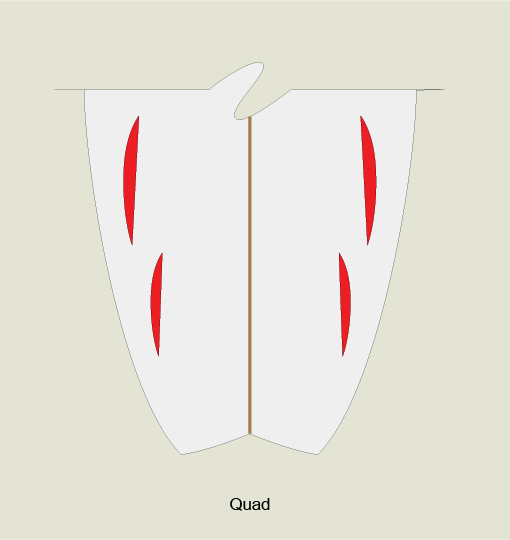
|
|
|
|
|
QUADS FINS Quad fin configurations offer acceleration, speed, and
maneuverability in all conditions. The two fins, the leading fin and
the trailing fin, configured near each other on each rail increase
the surface area of fin on rail offering additional projection and
power. The absence of a center fin notably reduces drag. The leading
fins in a quad set are the same size as the rail fins in a thruster
set and feature a flat foil. The trailing fins commonly have about
80% the surface area, depth, and base of the leading fins and feature
either a flat or 80/20 foil. Quads fins are common to boards surfed
in hollow barrels and fast down the line waves on point, reef, and
beach breaks. Quad fins are also common and very functional for XXL
waves. |
|
|
|

|
|
|
|
|
THRUSTERS The thruster fin configuration is the most common
contemporary fin configuration. It is common and functional on nearly
every class of surfboard. The front or rail fins are set angled near
the center of the board at the nose. They typically feature a flat
foiled inside surface (high pressure side when turning a board) to
increase lift and projection. The center fin features a symmetrical
foil to offer stability. |
|
FIN DESIGN FEATURES |
|
|
|
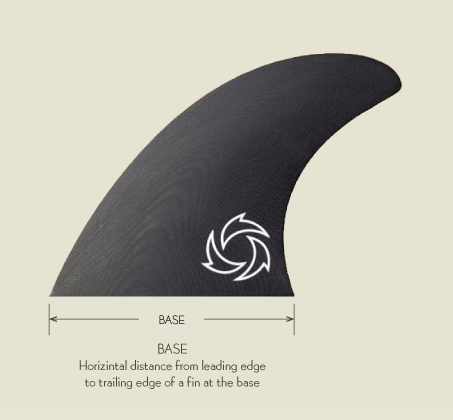
|
|
|
BASE The base is the length of the bottom of the fin where it is
attached to a board. A longer base offers more lift and projection. A
shorter base offers less lift and more maneuverability. |
|
|
|
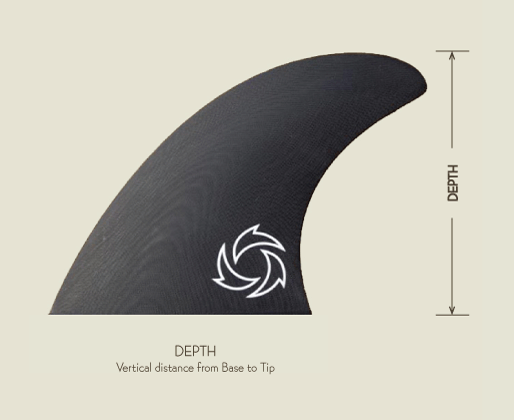
|
|
|
DEPTH The depth of a fin is the length of the fin from base to tip
in a straight vertical line. Deeper fins offer more holding power -
shallower fins less. Deeper fins provide longer turns and more
projection - shallower fins provide a tighter turning radius and more
maneuverability. |
|
|
|
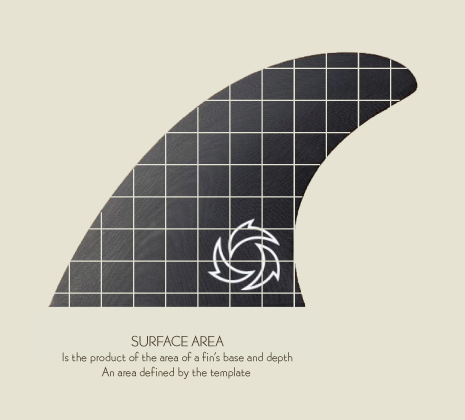
|
|
|
SURFACE AREA The surface area of a fin is a product of the geometry
of a fin's template. It is the area of the surface of a fin. Surface area is a
square measurement. A fin with more surface area will have more holding power
and more projection. A fin with less surface area will have less holding power
and less projection. Of note, more surface area increases drag and less surface
area reduces drag. |
|
|
|
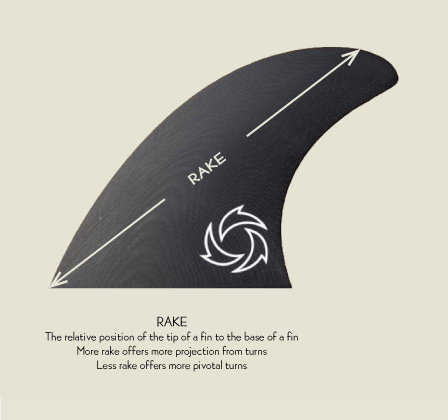
|
|
|
RAKE Rake references the relative position of the tip of the fin to
the base of the fin. A fin with more rake has the tip of the fin
further aft relative to the base. A fin with less rake has the tip of
the fin less aft relative to the base. More rake promotes more
projection from turns. Less rake promotes more pivotal turns. |
|
|
|
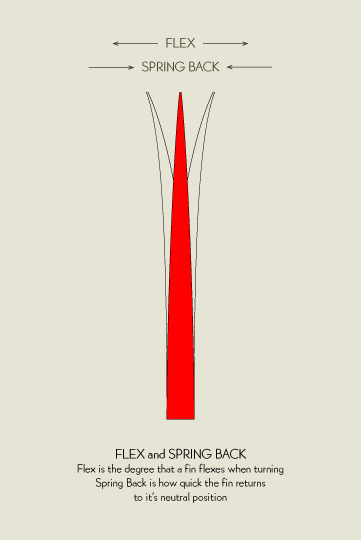
|
|
|
FLEX Fin flex and spring back is the degree that a fin flexes or
bends side to side and springs back to it's neutral centered position when on
rail or turning a board. The degree that a fin flexes and springs back are
determined by the foil, dimensions, and thickness of the fin and the surfer's
technique. A well foiled fin will flex and spring back predictably and
consistently providing surfer and board optimum performance. A thicker foil
will generally have a stiffer flex pattern and quicker spring back. A thinner
foil will have a softer flex pattern and slower spring back. A heavy footed
surfer will generate more flex when on rail or turning a board. A light footed
surfer will generate less flex. Flex and spring back function to help
accelerate a board when engaging the rails and out of turns. Stiffer flex and
spring back generate more acceleration and speed and great control in quality
surf. Softer flex will generate acceleration and speed as well and can help
generate those performance features in marginal surf. Flex that is too stiff
won't offer much acceleration. Flex that is too soft offers no
acceleration. |
|
|
|

|
|
|
TOE The toe of a fin set up is the angle that the rail fins are
pointed towards the stringer or center of the board at the nose. Fins
set more parallel to the stringer will offer longer radius turns and
more projection. Fins set angled closer to the center of the board at
the nose offer tighter turning radius and more maneuverability.
Shapers can set the toe of fins with measurements at the leading and
trailing edge of the fins relative to the stringer or center line of
a board. Alternatively, toe can be set with a lengthy straight edge
aligned with the position of the fin's trailing edge at its base and a
position relative to the center of the nose of the board. |
|
|
|
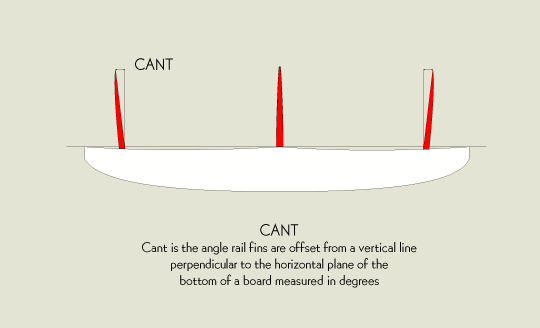
|
|
|
CANT Cant is the degree of outward angle a rail fin is set in
relation to the horizontal plane of the bottom of a board. Cant is measured in
degrees. A fin set with more cant will offer less projection but more
maneuverability. Conversely, a fin set with less cant will offer more
projection and less maneuverability. A cant of 6.5 degrees off a board's
horizontal plane is common and offers a nuanced balance of projection and
maneuverability. |
|
FIN FOILS
FOILS Surfboard fin foils are the shape and geometry of both sides
of fins. Both sides of single fins and center fins in thruster configurations
and the inside and outside surfaces of rail fins for twin fins, quads,
thruster, and 2 x 1 configurations all have nuanced foils best suited for their
design. Foils determine how water moves over the surface of fins. Foil
configurations and geometry affect lift and drag and ultimately can be designed
to yield particular and relevant performance features for fins. A functional
and efficient fin will have different design features for different surfboard
designs, surfers, and waves. Certain fin configurations and foils are ideal for
small and moderate surf, marginal and clean conditions, bigger surf, or XXL
surf. Some configurations and foils are universal and span several if not all
designs, surfers, waves, and conditions. |
|
|
|

|
|
|
|
FIN FOIL CLASSES
|
|
|
|

|
|
|
|
FLAT FOILS A flat foil features a flat inside surface and a convex
outside surface. As a board moves through the water the flat inside surface is
the high pressure side of the fin and the convex outside surface is the low
pressure side of the fin. With the forward movement of a board through water
the fins create lift providing the board with acceleration and speed. This
performance feature distinctly separates boards with rail fins - twin fins,
quads, and thrusters, from the neutral feeling of a single fin. The 2 x 1 fin
configuration adds an element (feature) of lift and extra acceleration and
speed to a single fin. A flat foil offers a balanced combination of projection,
release and control across a wide spectrum of surfboards, surfers, waves, and
conditions. The performance, stability, consistency, predictability, and
reliability of flat foils make them the most common foil for twin fins, quads,
and thrusters
|
|
|
|

|
|
|
|
INSIDE FOILS An inside or concave foil features a concave inside
surface and a convex outside surface. Inside foils are also know as "Vector"
foils. The leading edge has a neutral asymmetrical foil. A concave surface over
the same template will have more surface area than a flat foil. (Simple
geometry.) The extra surface of an inside foil offers more lift. The extra lift
is an asset in smaller, slower, flat faced waves at slower speeds. In better
waves the extra surface area has more drag and can slow a board down
particularly between turns.
|
|
|
|

|
|
|
|
ASYMMETRICAL 80/20 FOILS An asymmetrical or 80/20 foil features the
combined performance of a flat and a symmetrical foil. This foil provides the
lift and acceleration from the inside or high pressure side of the fin and the
stability and the control of a convex symmetrical foil from the outside or low
pressure side of the fin. The leading edge has a neutral asymmetrical foil. An
80/20 foil is common to trailers in quad configurations. This foil is also an
intriguing option for twin fins. |
|
|
|

|
|
|
|
SYMMETRICAL 50/50 FOILS A symmetrical or 50/50 foil is used on all
single fins and center fins. Both sides have a convex surface. Water flows
equally on both sides creating a neutral, stable and controlled fin. A
symmetrical foil is often used in quad trailers in quality or XXL waves for
control and release in critical surfing.
|
